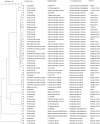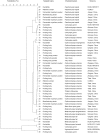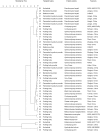Discriminatory Power Evaluation of Nuclear Ribosomal RNA Barcoding Sequences Through Ophiocordyceps sinensis Related Samples
- PMID: 30405561
- PMCID: PMC6206270
- DOI: 10.3389/fmicb.2018.02498
Discriminatory Power Evaluation of Nuclear Ribosomal RNA Barcoding Sequences Through Ophiocordyceps sinensis Related Samples
Abstract
Since the cost of Ophiocordyceps sinensis has increased dramatically and the counterfeits may have adverse effect to health, a rapid and precise species-level DNA barcoding identification system could be a potent approach and significantly enhance the regulatory capacity. The discrimination power of three subunits sequences from nuclear ribosomal RNA gene cluster were determined by Simpson's index of discrimination using 43 wild O. sinensis fruiting bodies, pure cultures, commercial mycelium fermented powder and counterfeits. The internal transcribed spacer (ITS) sequences showed the highest variance and discrimination power among 43 samples, as determined by Simpson's index of discrimination (D = 0.972), followed by large subunit (LSU; D = 0.963) and small subunit (SSU; D = 0.921). ITS-2 sequences showed the highest discrimination power for 43 samples among ITS-1, ITS-2, and 5.8S region of ITS sequences. All O. sinensis samples were grouped into a unique ITS sequence cluster under 95% similarity and two O. sinensis samples and six non-O. sinensis samples showed false claims. Our data showed that the ITS region could provide accurate species identification for O. sinensis samples, especially when macroscopic and microscopic method could not be applied in the highly processed commercial products. Since the authentication of O. sinensis related products is essential to ensure its safety and efficacy, identification of O. sinensis through ITS sequence comparison or unique PCR amplification of the species specific target, such as the ITS region, should be considered in the next revision of Chinese pharmacopeia.
Keywords: ITS; Ophiocordyceps sinensis; Simpson index of diversity; discriminatory analysis; nuclear ribosomal RNA barcoding sequences.
Figures



Similar articles
-
Identification of Ophiocordyceps sinensis and Its Artificially Cultured Ophiocordyceps Mycelia by Ultra-Performance Liquid Chromatography/Orbitrap Fusion Mass Spectrometry and Chemometrics.Molecules. 2018 Apr 26;23(5):1013. doi: 10.3390/molecules23051013. Molecules. 2018. PMID: 29701667 Free PMC article.
-
DNA barcoding the commercial Chinese caterpillar fungus.FEMS Microbiol Lett. 2013 Oct;347(2):156-62. doi: 10.1111/1574-6968.12233. Epub 2013 Aug 28. FEMS Microbiol Lett. 2013. PMID: 23927075
-
Detection of Ophiocordyceps sinensis and Its Common Adulterates Using Species-Specific Primers.Front Microbiol. 2017 Jun 21;8:1179. doi: 10.3389/fmicb.2017.01179. eCollection 2017. Front Microbiol. 2017. PMID: 28680424 Free PMC article.
-
The Mechanisms of Pharmacological Activities of Ophiocordyceps sinensis Fungi.Phytother Res. 2016 Oct;30(10):1572-1583. doi: 10.1002/ptr.5673. Epub 2016 Jul 3. Phytother Res. 2016. PMID: 27373780 Review.
-
The artificial cultivation of medicinal Caterpillar Fungus, Ophiocordyceps sinensis (Ascomycetes): a review.Int J Med Mushrooms. 2013;15(5):425-34. doi: 10.1615/intjmedmushr.v15.i5.10. Int J Med Mushrooms. 2013. PMID: 24266368 Review.
Cited by
-
The invasion process of the entomopathogenic fungus Ophiocordyceps sinensis into the larvae of ghost moths (Thitarodes xiaojinensis) using a GFP-labeled strain.Front Microbiol. 2022 Sep 2;13:974323. doi: 10.3389/fmicb.2022.974323. eCollection 2022. Front Microbiol. 2022. PMID: 36118238 Free PMC article.
-
The phylogeny and divergence time of Ophiocordyceps sinensis and its host insects based on elongation factor 1 alpha.Arch Microbiol. 2023 Feb 28;205(3):98. doi: 10.1007/s00203-023-03444-9. Arch Microbiol. 2023. PMID: 36853446
-
Haplotype Diversity of NADPH-Cytochrome P450 Reductase Gene of Ophiocordyceps sinensis and the Effect on Fungal Infection in Host Insects.Microorganisms. 2020 Jun 29;8(7):968. doi: 10.3390/microorganisms8070968. Microorganisms. 2020. PMID: 32610431 Free PMC article.
References
-
- Demczuk W., Sidhu S., Unemo M., Whiley D. M., Allen V. G., Dillon J. R., et al. (2017). Neisseria gonorrhoeae sequence typing for antimicrobial resistance, a novel antimicrobial resistance multilocus typing scheme for tracking global dissemination of N. gonorrhoeae strains. J. Clin. Microbiol. 55 1454–1468. 10.1128/JCM.00100-17 - DOI - PMC - PubMed
LinkOut - more resources
Full Text Sources

